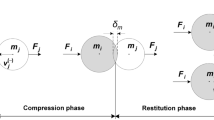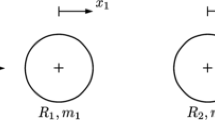Abstract
The construction of multibody biomechanical models for impact is discussed here with the emphasis on the formulation aspects. First the relations between the human or the dummy anthropometric data and the rigid bodies in the model are presented. The motion restrictions between the different anatomical segments of model can be defined as kinematic joints, suitable to represent mechanical joints of dummies or a simplified kinematics of human joints, or as contact/sliding pairs, which are used to describe realistic human like anatomical joints. Another particular aspect of biomechanical models is the representation of the range of motion of the anatomical joints. This is achieved either by setting proper contact pairs between the adjacent anatomical segments or by setting resisting muscle forces or resisting moments that develop when the relative orientation between the segments reach critical values. Another fundamental aspect of the models is the ability to represent the contact geometries and the contact forces with realism. In fact, the outcome of all injury indexes predictions is strongly dependent on the quality of the representation of the contact. Contact models suitable to be used in biomechanical models, to represent the contact between anatomical segments of the biomechanical model or between these and external objects, are presented and discussed emphasizing the requirements to develop more advanced biomechanical models. The current biomechanical models either do not include muscle actions or, at the most, include a reflexive muscle contraction. It is suggested here that for the case of standing passengers it is important to include in the biomechanical models muscle models that allow for the representation of the muscle voluntary contractions and joint stiffening. It is also suggested that the evaluation of the models leading to the identification of such actions can be done by using techniques similar to those used in the evaluation of muscle force sharing in different human motions.
Access this chapter
Tax calculation will be finalised at checkout
Purchases are for personal use only
Preview
Unable to display preview. Download preview PDF.
Similar content being viewed by others

References
Kamal, M.M., Analysis and simulation of vehicle-to-barrier impact, in International Automobile Safety Conference Compendium, SAE Paper No. 700414, SAE, Inc., 1970.
Ambrósio, J.A.C. and Pereira, M.S., Multibody dynamic tools for crashworthiness and impact, in Crashworthiness on Transportation Systems: Structural Impact and Occupant Protection, Ambrósio, J.A.C. and Pereira, M.S. (eds.), Kluwer Academic Publishers, Dordrecht, The Netherlands, 1997, pp. 475–521.
King, H.Y., Pan, H., Lasry, D. and Hoffman, R., Finite element modelling of the hybrid III dummy chest, in Crashworthiness and Occupant Protection in Transportation Systems, AMD-Vol. 126/BED-Vol.19, ASME, 1991.
Haug, E. and Ulrich, D., The PAM-CRASH code as an efficient tool for crashworthiness simulation and design, in Proceedings of the Second European Car/trucks Simulation Symposium, Munich, Germany, 1988.
Belytschko, T. and Kenedy, J.M., WHAMS-3D, An Explicit 3D Finite Element Program, KBS2 Inc., Willow Springs, Illinois, 1988.
Halquist, J.O., Theoretical Manual for DYNA-3D, Lawrence Livermore Laboratory, 1982.
Fleck, J.T. and Butler, F.E., Validation of the Crash Victim Simulator, Vol. 1: Engineering Manual, Part I: Analytical Formulations, NTIS, No. Pb86-21243-8, 1981.
MADYMO Theory Manual version 6.2, TNO MADYMO BV, Delft, The Netherlands, 2004.
Wismans, J., Design tools: human body modeling, in Crashworthiness: Energy Management and Occupant Protection, Ambrósio, J. (ed.), Springer, Wien, Austria, 2001, pp. 333–366.
Viano, D.C. and Lau, I.V., A viscous tolerance criterion for soft tissue injury assessment, Journal of Biomechanics, 21, 1988, 387–399.
Silva, M. and Ambrósio, J., Out-of-position occupant models in a multibody integrated simulation environment, in Proceedings of the IRCOBI2002 International IRCOBI Conference on the Biomechanics of Impact, Munich, Germany, September 18–20, 2002.
Silva, M. and Ambrósio, J., Solution of the redundant muscle forces in human locomotion with multibody dynamics and optimization tools, Mechanics Based Design of Structures and Mechanisms, 31(3), 2003, 381–411.
Seireg, A. and Arvikar, R., Biomechanical Analysis of the Muscoloskeletal Structure for Medicine and Sports, Hemisphere Pub. Corp., New York, 1989.
Jalon, J.G. and Bayo, E., Kinematic and Dynamic Simulation of Mechanical Systems — The Real-Time Challenge, Springer-Verlag, Berlin, Germany, 1994
Silva, M., Ambrósio, J. and Pereira, M., A multibody approach to the vehicle and occupant integrated simulation, International Journal of Crashworthiness, 2(1), 1997, 73–90.
Hertz, H., Gesammelte Werk, Leipzig, Germany, 1895
Lankarani, H.M. and Nikravesh, P.E., Continuous contact force models for impact analysis in multibody systems, Nonlinear Dynamics, 5, 1994, 193–207.
Kapandji, I.A., The Physiology of the Joints: Vol. 3, Churchill Livingstone, Edinburgh, United Kingdom, 1974.
Murial, W., 3D Modeling of the Human Upper Limb Including the Biomechanics of Joints, Muscles and Soft Tissues, Ph.D. Thesis, Ecole Polytechnique Fed. de Lausanne, Lausanne, Switzerland, 1999.
Jager, De M., Sauren, A., Thunnissen, J. and Wismans, J.S.H.M., A three-dimensional head-neck model: Validation for frontal and lateral impacts, in Proceedings of the 38th Stapp Car Crash Conference, SAE Paper No. 942211, 1994.
O'Riordain, K., Thomas, P.M., Philips, J.P. and Gilchrist, M.D., Modelling and accident reconstruction of real world head injury accidents resulting from falls using multibody dynamics, Journal of Clinical Biomechanics, 18, 2003, 590–600.
Wismans, J., Veldpaus, F. and Janssen, J., A three-dimensional mathematical model of the knee-joint, Journal of Biomechanics, 13, 1980, 677–685.
Hirokawa, S., Biomechanics of the knee joint: a critical review, Critical Reviews in Biomechanical Engineering, 21(2), 1993, 79–135.
Leardini, A., O'Connor, J.J., Catani, F. and Giannini, S., A geometric model of the human ankle joint, Journal of Biomechanics, 32, 1999, 585–591.
Van der Helm, F. and Pronk, G.M., Three-dimensional recording and description of motions of the shoulder mechanism, Journal of Biomechanical Engineering, 117, 1995, 27–40.
Hogfors, C., Sigholm, G. and Herberts, B., Biomechanical model of human shoulder joint — I. Elements, Journal of Biomechanics, 20, 1987, 157–166.
Stronge, W.J., Impact Mechanics, Cambridge University Press, Cambridge, England, 2000.
Yamada, H., Strength of Biological Materials, The Williams and Wilkins Company, Baltimore, Maryland, 1970.
Allard, P., Stokes, I. and Blanchi, J., Three-Dimensional Analysis of Human Movement, Human Kinetics, Urbana-Champaign, Illinois, 1995.
Nigg, B. and Herzog, W., Biomechanics of the Musculo-Skeletal System, John Wiley & Sons, New York, 1999.
Addel-Aziz, Y. and Karara, H., Direct linear transformation from comparator coordinates into object space coordinates in close-range photogrammetry, in Proceedings of the Symposium on Close-range Photogrammetry, Falls Church, Virginia, 1971, 1–18.
Silva, P., and Ambrósio, J. Kinematic data consistency in the inverse dynamic analysis of biomechanical systems, Multibody System Dynamics, 8, 2002, 219–239.
Ambrósio, J.A.C., Nikravesh, P.E. and Pereira, M.S., Crashworthiness analysis of a truck, Journal of Mathematical Computer Modelling, 14, 1990, 959–964.
Author information
Authors and Affiliations
Editor information
Editors and Affiliations
Rights and permissions
Copyright information
© 2005 Springer
About this paper
Cite this paper
Ambrósio, J., Silva, M. (2005). Multibody Dynamics Approaches for Biomechanical Modeling in Human Impact Applications. In: Gilchrist, M.D. (eds) IUTAM Symposium on Impact Biomechanics: From Fundamental Insights to Applications. Solid Mechanics and Its Applications, vol 124. Springer, Dordrecht. https://doi.org/10.1007/1-4020-3796-1_7
Download citation
DOI: https://doi.org/10.1007/1-4020-3796-1_7
Publisher Name: Springer, Dordrecht
Print ISBN: 978-1-4020-3795-5
Online ISBN: 978-1-4020-3796-2
eBook Packages: EngineeringEngineering (R0)



